Horus has risen against the Emperor and the galaxy burns, including some of the lesser-known bits of it. So far, Exemplary Battles have been a series of free downloads published on Warhammer Community, bringing us the background of some of these battles, rules for units that took part in them and a scenario or two. This is the first time we’re seeing these articles published in a physical book. We’ll look at whether it’s worth paying for and piling the weight of yet another heavy book to your spine. Thanks to Games Workshop for sending us a copy of the book to review.
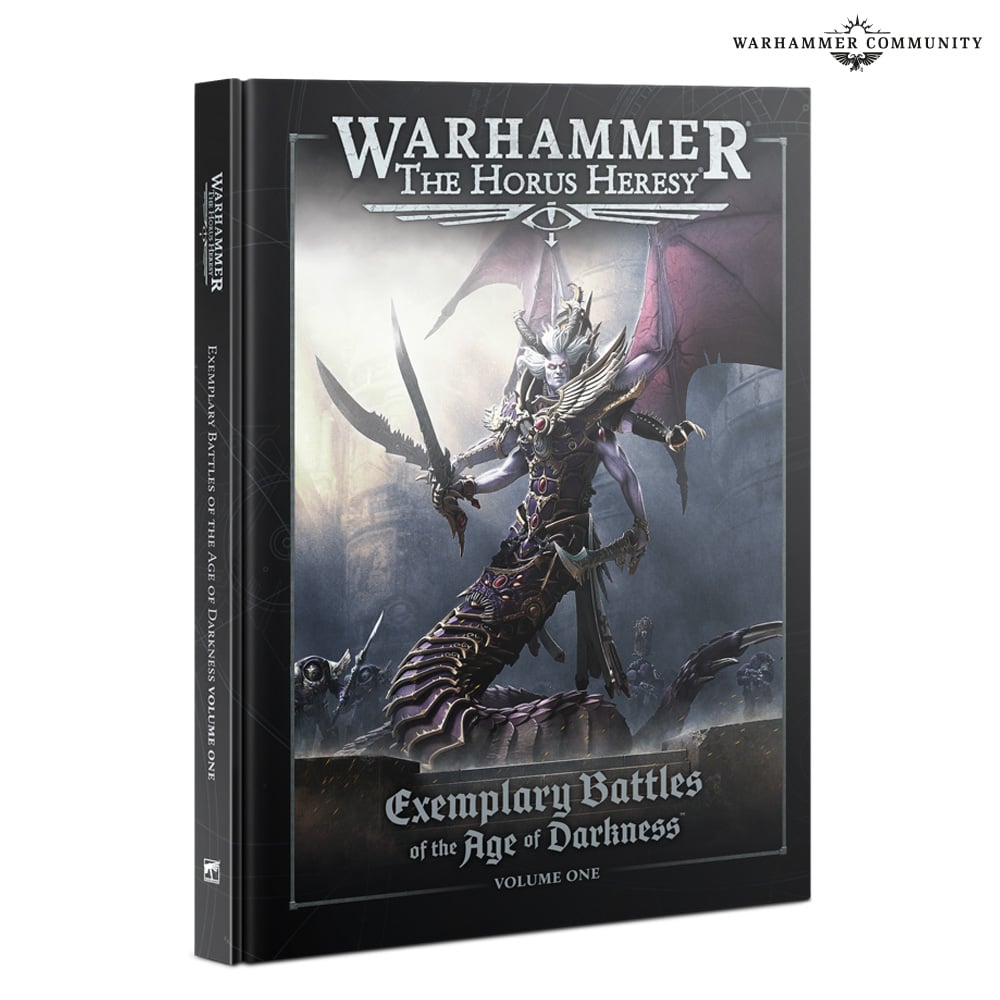
Table of Contents
What’s in the book?
The bulk of Exemplary Battles of the Age of Darkness: Volume One contains a series of separate Exemplary Battles articles. Four of the five of these have published earlier online for free, though one is new. Then at the end of the book is the most interesting section: the rules for Fulgrim and Legiones Hereticus – the corrupted versions of the Traitor Legions.
Since the release of 2.0, online releases have typically been Extended units rather than Core units – meaning that they were subject to change. For what it’s worth, everything in this book is Core apart from Arcology Incursion Brutes, which can only be used in a particular scenario and not in other games.
The Exemplary Battles articles are:
- The Defence of Sotha, featuring the Night Lords Atramentar Squad.
- The Siege of Hydra Cordatus, featuring the Iron Warriors Dominator Cohort.
- The Battle of Armatura, featuring the World Eaters Red Hand Destroyers.
- The Battle of Calth, featuring the Ultramarines Nemesis Destroyer Squad.
- The Purging of the Invocatus Sector, aka “the new one”, featuring the Salamanders Sanctifier Squad.
Each Exemplary Battle also includes at least one narrative mission and in three cases you get a little campaign with two or three missions to play. Many already exist online for the first edition of Horus Heresy. This book updates them for the new-ish edition.
These could be the most fun feature of the book and the main selling point for “neutral” players who don’t play the Legions in here. You can play the battles with any Legions, not just the ones who were there “historically”. The missions are asymmetric, with attackers and defenders trying to achieve different objectives, which may not always be equally easy to do. They aren’t intended for matched play but could be a fun change from the rulebook missions or provide inspiration for your own custom scenarios. This book includes three new Zone Mortalis missions, to be used with the rules published in The Siege of Cthonia.
As for the rules for the units, these are virtually unchanged from the Exemplary Battles Unit Update, published last year. Night Lords get some minor changes to the Atramentars’ costs but the others are unchanged from the rules you can download for free, for now. Hopefully these rules will still be available online after the book is published, but I’d probably save a copy of it now, just in case.
Each of the units gets a Unit showcase. These are pretty basic and can be summed up as “we got some suitable bodies and stuck different weapons on them”. They aren’t detailed guides to doing conversions and actually none of the examples are more than head and arm swaps. You can often find far more interesting work done by the community. They do show some of the ways these units can be painted, but they are clear that these are just examples and you can do yours however you like.
After all the exemplary battles there’s a section telling us the rules for Daemon Primarchs, which are a lot like Primarchs but a bit more Daemonic. Basically instead of being Fearless their unit loses D3 wounds if they fail a morale check. Interestingly, they are still Independent Characters so they can join units, unlike the Daemons of the Ruinstorm. They can get in transports too, though with Bulky (6). I’m not sure it would be possible for Fulgrim to make it out of a Spartan’s door with his dignity intact, but he’s allowed to. They also have Fear (2), which makes sense if you’ve seen Fulgrim’s model.
Then we learn about how Legiones Hereticus. Essentially these are entirely new Legion templates that replace all the rules you’d normally get for your Legion. We are given the rules for Legiones Hereticus (Emperor’s Children) here.
Anyway, let’s have a look at all these different sections.
The Defence of Sotha
Sotha was the location of the weird Xenos device known as the Pharos, which made it a target for the Night Lords. We get a story in which the Night Lords turn up at Sotha and proceed to do Night Lord-y things to the civilian population, the Ultramarine defenders and each other.
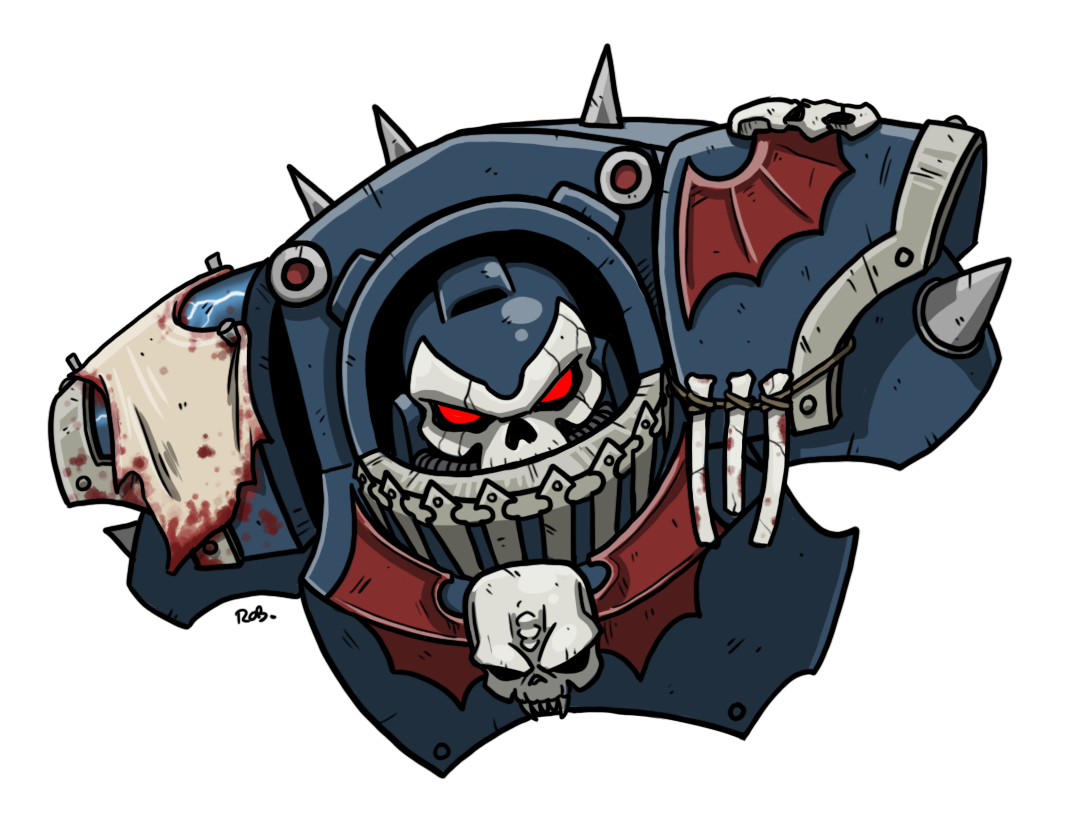
Night Lords Atramentar Squad
These are Tartaros Terminators with fairly normal stats and equipment, but are quite a lot more points. They can have the usual upgrades, plus some Night Lords kit. Upgrades are a bit cheaper than usual, including free single lightning claws or Chainglaives, which helps mitigate the initial purchase price.
Atramentar have three special rules that really make them useful. Deep Strike is excellent and Fear (1) makes complete sense for these very nasty people in terminator armour. Their unique rule Cloaked in Murder gives them +1 to charge rolls and +1 to hit in melee for the turn if they charge a unit that’s already locked in melee.
They come in units of 5-20 (yes, twenty), so you could either have several small units deep strike together or build a massive death star. Finally, Sevatar lets you take them as non-compulsory troops (though not Line) and makes them count as Tartaros squads for his warlord trait.
Sothopolis Burns
This is a single scenario in which the attacker scores a VP each turn for every Scoring unit in the defender’s deployment zone, while the defender earns a VP for every unit they kill. It uses Hammer and Anvil deployment. The attacker has to put all their Heavy Support, Lords of War and one Elite and Troop unit into reserve, which will make it tricky to get them across the board unless they can deep strike or outflank.
The Siege of Hydra Cordatus
Here we find the Iron Warriors roaming around looking for Imperial Fists to take revenge on, following the battle of Phall. They show up with their whole fleet above the planet and nuke pretty much everything from orbit except for the Cadmean Citadel, where a company of Imperial Fists are sitting around doing nothing much. They then charge headlong at the heavily defended fortress, predictably suffering enormous casualties, till Perturabo steps in and sorts things out.
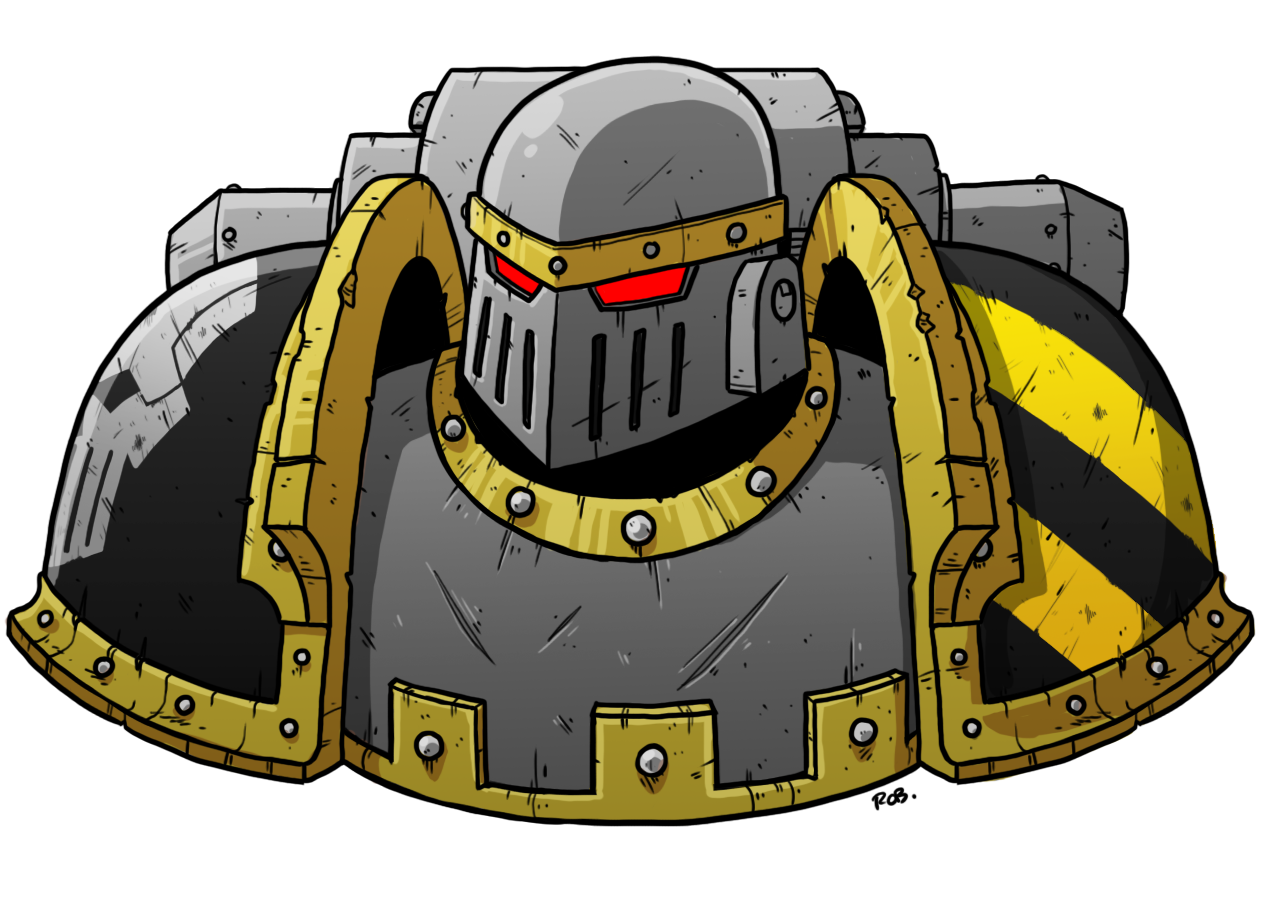
Iron Warriors Dominator Cohort
These are a 0-1 Elites choice of 5-10 Cataphractii, all of which come with Combi-bolters and Thunder Hammers, which you can replace with Chainfists for free if you want. They have WS5, Stubborn, hate Automata (who took their jobs as Perturabo’s bodyguard) and are Chosen Warriors.
The Those Once Honoured rule allows you to field your Dominators as they were in happier times as Perturabo’s retinue squad, before they embarrassed themselves at Phall. They get 6+ Feel No Pain while serving as his bodyguard instead of hating robots.
WS5 Cataphractii with thunder hammers for a reasonable price are simply great. They’d definitely make a good retinue for Perturabo but are very good on their own too.
The Sundering of the Cadmean Citadel Campaign
This is a campaign of two missions. The Iron Tide is a relatively straightforward mission featuring D3+1 objectives in midfield. If you control one at the end of your turn you get a VP if you can roll a 4+, or nothing on a 1-3. Secondary for the defender is one extra VP if they’ve got most units on the battlefield at the end of the battle. The attacker can earn a VP for Into the Breach – getting a Scoring unit within 6″ of the defender’s table edge at the end of the battle.
If the attacker scores Into the Breach you go onto mission two, regardless of who won the mission. If not you can end up playing the first up to three times, first with Dawn of War deployment, then Hammer and Anvil, then Clash of the line. You go onto mission two regardless of the outcome of the third Iron Tide.
Vengeful Strike is a Zone Mortalis mission. Both players score standard kill points for destroying the enemy. The defender gets D3 points for any units that end the game in the attacker’s deployment zone, while the attacker gets 3 VPs for units within 6″ of the defender’s battlefield edge or two just for being within 6″ of a flank. So it’s quite a bit easier for the attacker to score points, but this is mitigated by the fortress itself coming alive and trying to kill them with its Semi-sentient Defences.
Whoever wins Vengeful Strike wins the campaign. The Iron Tide doesn’t really matter, other than to showcase the bitter attritional warfare the Iron Warriors seemed to enjoy.
The Battle of Armatura
Armatura was an important transport hub, manufacturing and recruiting world for the Ultramarines, which got attacked by the combined Word Bearers and World Eaters fleets. These fleets smash through the system’s outer defences but then Angron opts not to use their enormous firepower to simply level the planet, opting instead for a ground invasion. World Eaters and Legio Audax then rampaged about the place, desperately opposed by Ultramarines and Legio Lysanda.

World Eaters Red Hand Destroyer Assault Squad
This is a lot like a normal Destroyer Squad with some World Eater upgrades. They can have Caedere Weapons, though they pay many points for them, and also your choice of Thunder hammers or the usual rad missile launchers. Jump packs are available too but some of the other usual ranged weapons Destroyers would get are not. It’s a unit of 5-15, which is bigger than usual for Destroyers.
Their special rule Bearers of the Blood Hand means they have to charge if within 12″ of an enemy, while Ravaging Assault gives them +1 to combat resolution and Sweeping Advances on the turn they charge.
Red Hand Destroyers are complete lunatics who might be pretty effective. Rad grenades and many, many attacks will result in serious harm being caused to pretty much anything they can reach with their chain axes and thunder hammers. They’re pretty soft, with 1 wound and 3+ saves, but they could kill things much more expensive than they are if they get the chance.
Razing of the Decalian District
This is a campaign with three attacker/defender missions. You total up the VPs scored in the first two missions to decide who will be the attacker in the third, and whoever wins that mission wins the campaign. The Fog of War caused by the city being destroyed has random effects, rolled for each game. All units might get shrouding 6+, night fighting might be in effect all game or the Scouring winds might give all attacks against infantry +1 to wound.
Sector Control is fought over 5 objectives, which are placed in the defender’s table half. You roll for each one you control at the end of your turn. The defender gets a VP on a 4+, while the attacker gets a VP on a 2-4 and on a 5+ they raze the objective, removing it, and earn 3VPs.
Line Advance is actually pretty symmetrical, except that the attacker gets the first turn (as usual) unless the defender can seize. It’s played as Hammer and Anvil. At the start of your turn you get a VP for every Scoring unit entirely in midfield and 2 VPs if they’re in the enemy deployment zone.
Ambush is played using the Ambush deployment, with the defender in the middle. Here you get 3Vps for slaying the opposing Warlord and just a couple of small secondaries, meaning that it’s pretty much all down to Killing the enemy leader and keeping your own alive. The deployment and giving the attacker first turn put the defender at a significant disadvantage.
The Battle of Calth
You’ve probably heard about this one. The Word Bearers attack the Ultramarines at Calth and do something weird to its star, meaning all subsequent fighting has to be conducted indoors. Death and destruction follow, with one of the earliest appearances of Daemons on the 30k battlefield.
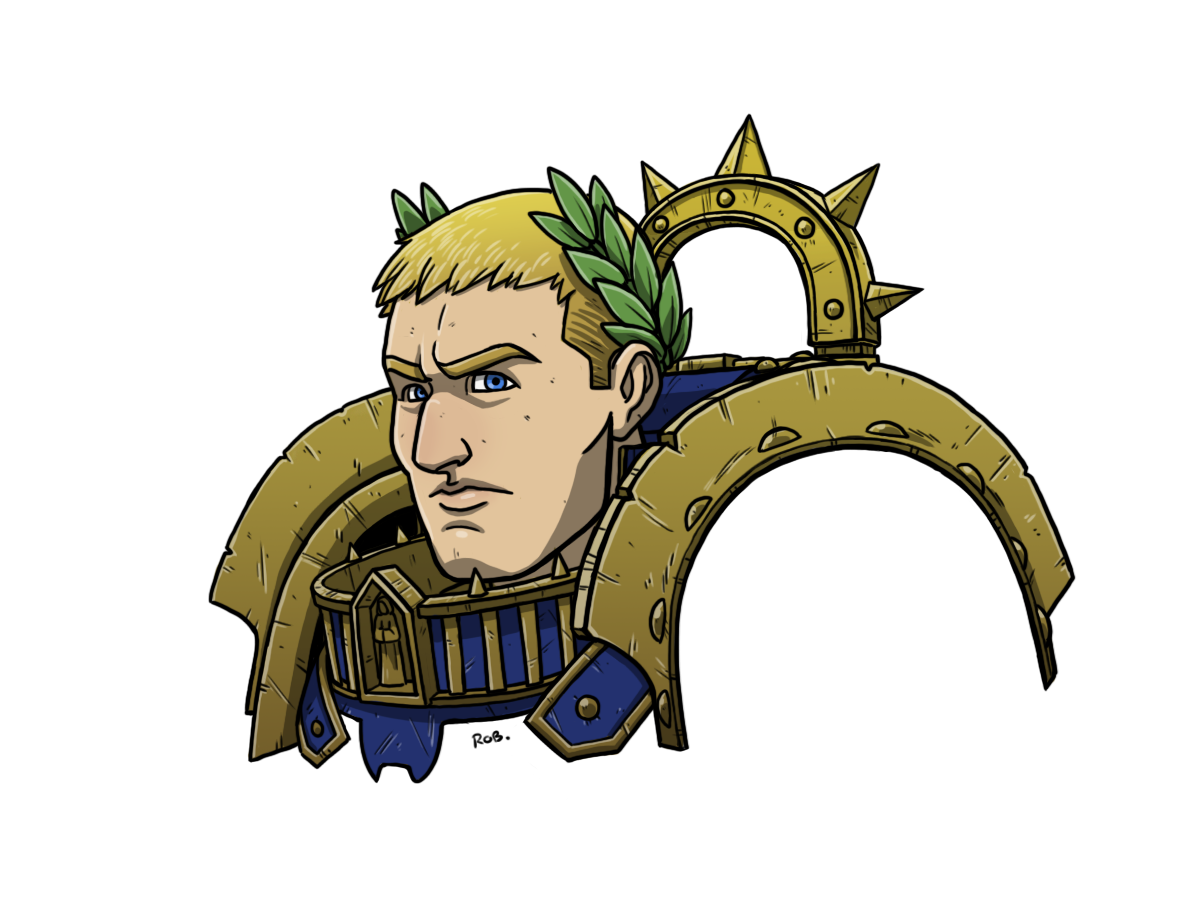
Ultramarines Nemesis Destroyer Squad
These have the same profile as Legion Destroyers and much of the same equipment. However they come in units of 10-20, with a pretty reasonable cost for the first 10 models, particularly given that they come with loads of equipment.
They are armed with Mortifier Bolters and only one bolt pistol, plus a chainsword and rad grenades. There’s no jump pack option but otherwise you get more or less the standard Destoyer weapon options. Mortifier Bolters are Assault 2 with 18″ range and their Harrower rule means the enemy who takes any casualties from them has to take a morale check that phase.
As you’d expect from Ultramarines, these guys are more measured than the Red Hands the World Eaters get. They’re able to shoot respectably and also fight quite well in melee, thanks to having 2 attacks each, 2 weapons and rad grenades.
The Scouring of the Auroran Arcology
This is a three-mission Zone Mortalis campaign. The outcome of each mission determines which mission you’ll play next and also awards bonuses to one side or the other in subsequent games. Throughout all the missions you are constantly rolling for random events like aftershocks and potentially radiation exposure, due to the Tortured World you’re fighting on.
You also get rules for Arcology Incursion Brutes. These can only be used in these scenarios. They’re basically a lot like the daemonic brutes you’ll find in the Ruinstorm lists, but with fewer special rules, perhaps representing a very early manifestation.
In Hunt and Eliminate the attacker gets VPs for destroying consoles that are vital for the Arcology’s survival, while the defender gets simple kill points. If the Defender wins you proceed to the decisive mission: The Heart of Desecration but if not you play Blood of the Betrayed.
Blood of the Betrayed is a symmetrical battle where both players are trying to get units into their opponent’s Deployment Zone at the end of the battle. The deployment zones are actually massive – you deploy in opposite quarters of the 4×4′ board with only a 6″ diameter circle in the middle excluded. Now if the attacker wins you play The Heart of Desecration but if the Defender wins you do Hunt and Eliminate again and then do The Heart of Desecration.
In The Heart of Desecration the Ultramarines become the attackers instead of defending, for once. They can deploy anywhere around the edge of the board, with the Word Bearers in the middle. There are three objectives, representing ritual sites, which are also where any defending reinforcements move on from. Players get 1VP at the end of each of their turns for controlling these. At the end of the game they get 2VPs for each objective they control or, in the attacker’s case, that the defender has destroyed – which they can do to increase their chances of having free Arcology Brutes pop out of one of the remaining sites.
The Purging of the Invocatus Sector
This begins with the Emperor’s Children fleeing through space, looking for a hiding place after the destruction of Chemos. The Salamanders detect them and chase some of them to a planet in the Pale Stars, only to find that the whole population has turned traitor. Things go increasingly badly for the Salamanders from there on, though they do get to light a bunch of stuff and quite a lot of people on fire.

Salamanders Sanctifier Squad
This is basically a Veteran Squad of 5-10 elite marines (WS5, 2 wounds and attacks) with slightly different weapon options. They are Stubborn but not Chosen Warriors. Instead of the melee weapons Veterans can usually have, Sanctifiers can have paired Volkite Serpeta or Hand Flamers and they also get access to an Obsidite Rotor Cannon or two per squad. These have Breaching 6+ but only 3 shots and no Shell Shock. They also have access to very expensive Thunder Hammers.
These guys are fun and should be a reasonably effective all-rounder unit. They’re probably a bit less dramatic than the other units in these articles but they’ll do work for you. I’d avoid throwing too many points in upgrades at this unit because you’d end up with a bit of a glass cannon.
The Bloodied Path
This is a single mission, using a modified Hammer and Anvil-like Deployment. The attacker only gets to deploy 12″ on while the defender is limited to the sides of their own deployment zone, with the two forces starting 36″ apart. There are 5 objectives, with the first in a zone 12″ from the attacker’s deployment zone and subsequent ones put increasingly far from it. The attacker has to move forward, scoring these objectives in sequence from turn 2 onwards. Meanwhile the defender gets simple Kill points, plus a bonus VP every time an attacking unit falls back.

Fulgrim Transfigured
Wow this is exciting, a Daemon Primarch, with a truly phenomenal model. So what’s he like in the game? Well… kind of bad to be honest.
Fulgrim Transfigured has a great stat line, featuring mostly 7s and the occasional 8, which is better than any other Primarch with the possible exception of Horus. His wings let him fly 14” like Sanguinius and Corax, though he can’t Deep Strike* like them. So far, so good.
*A new Rite of War gets around this partially, but we get ahead of ourselves.
The problems start with his Warlord Trait – and of course Fulgrim must be your Warlord so there’s no getting round this one. Fulgrim and his unit must declare a charge against any unit containing a model with WS6 or better that’s within 12”, even if they shot at something else. So if there’s a Praetor or Primarch around, Fulgrim will charge off after them. In practice you may be able to mitigate this problem using Fulgrim’s 14” move but it could sometimes cause real issues, including failed charges and getting baited off objectives.
Correction: when I first read this I thought Fulgrim always has to issue and accept Challenges personally, as Sigismund does. I now realise this is only when he reaches combat with a unit including one or more WS6 opponents. So he’s not going to spend his career chopping up random sergeants. You need to watch out for things like Praetors leading Command Squads, as he’s got to challenge and could get tar-pitted by Chosen Warriors – though Fear (2) will mean the enemy will often choose not to stick around while he does it. He always hits on a 2+ in a challenge with WS6 opponents unless they’re Primarchs or Daemons, which is nice but actually probably only affects Praetors and a few special characters so it won’t often come up.
As well as all of that, the first reaction Fulgrim’s own unit does in any given game turn doesn’t use up any reactions. That’s quite impactful, as he’s likely to be leading a pretty big unit, though it isn’t as flexible as some of the traits that give you extra reactions to use on whoever you want.
Fulgrim’s equipment is fairly modest. His “armour” is his Serpentine Daemonform, which gives him a 2+ save and 4+ invulnerable, which is about the baseline for Primarchs. When he’s on 4 wounds or fewer he gets +1 to It Will Not Die rolls. If at the start of his turn he has two wounds or fewer and, crucially, if he isn’t locked in combat, Fulgrim can choose to run away back to the warp, which (without wanting to give away too many spoilers) matches his behaviour in the books. He’s removed as a casualty but your opponent doesn’t get any VPs for killing him. But of course you want Fulgrim to be locked in combat a lot of the time, so don’t count on this option being available.
In melee Fulgrim has two profiles available. One gives him seven attacks at Ap2 with Murderous Strikes 4+. Alternatively, he can choose to have just three Unwieldy attacks, with S10 ap1 and Brutal (2), which might be useful against vehicles or other things. These attacks are pretty good, but many of the other other Primarchs have better. Despite costing a lot more than anyone but Horus, Fulgrim doesn’t have a ranged attack at all and doesn’t have psychic powers – he just chops stuff up.
His only other unique rule is Scion of Corruption, which just says all other Emperor’s Children units have to be Legiones Hereticus like him.
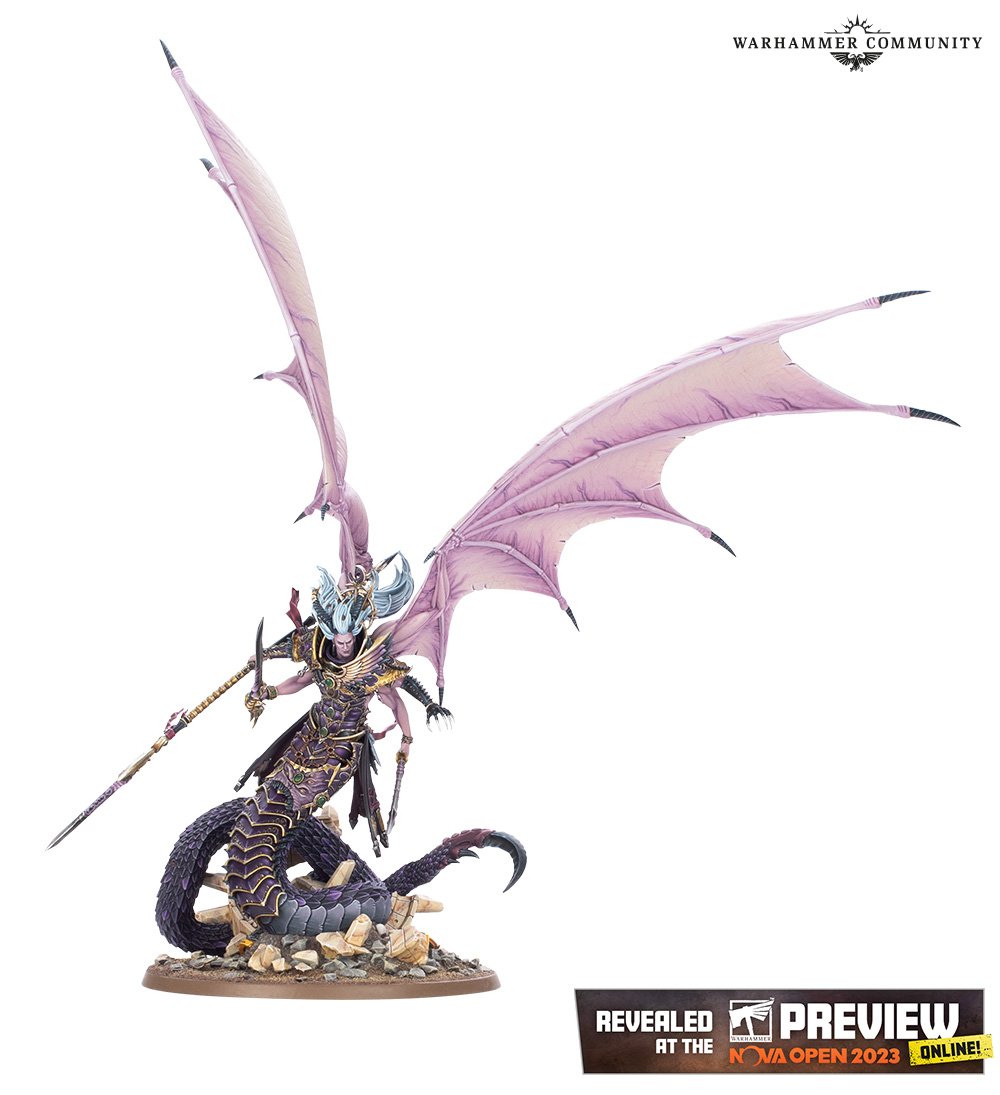
All of this adds up to an absolutely incredible model, with somewhat lacklustre rules for his cost. I think the best use for him might be to go with a jump pack assault squad of some kind. He can’t Deep Strike (except away from the battle if he gets hurt!) but you might be able to get the unit to outflank by adding another character. That way you’d be sure of getting him into combat. Don’t have him walk around on his own though, as he’ll just be shot down.
Legiones Hereticus (Emperor’s Children)
The Legiones Hereticus (X) rule completely replaces the Legiones Astartes (X) rule. This means that Legiones Hereticus don’t have access to any of their former equipment, special Consuls and so on. They can’t use their Legion’s Rites of War, or even the generic ones, as they aren’t “Legiones Astartes” anymore. They have to be Traitors too, which probably goes without saying.
You can have your Legion’s special units, including unique characters. They swap their Legiones Astartes rule for the corresponding Legiones Hereticus one. You get a new Advanced Reaction, special rules Rites of War and so on. It’s almost like a new set of Legion rules, just with some of the same units.
This does mean in order to field Fulgrim that you can only use one of the two specific Rites of War in this book, which we’ll cover in a moment.
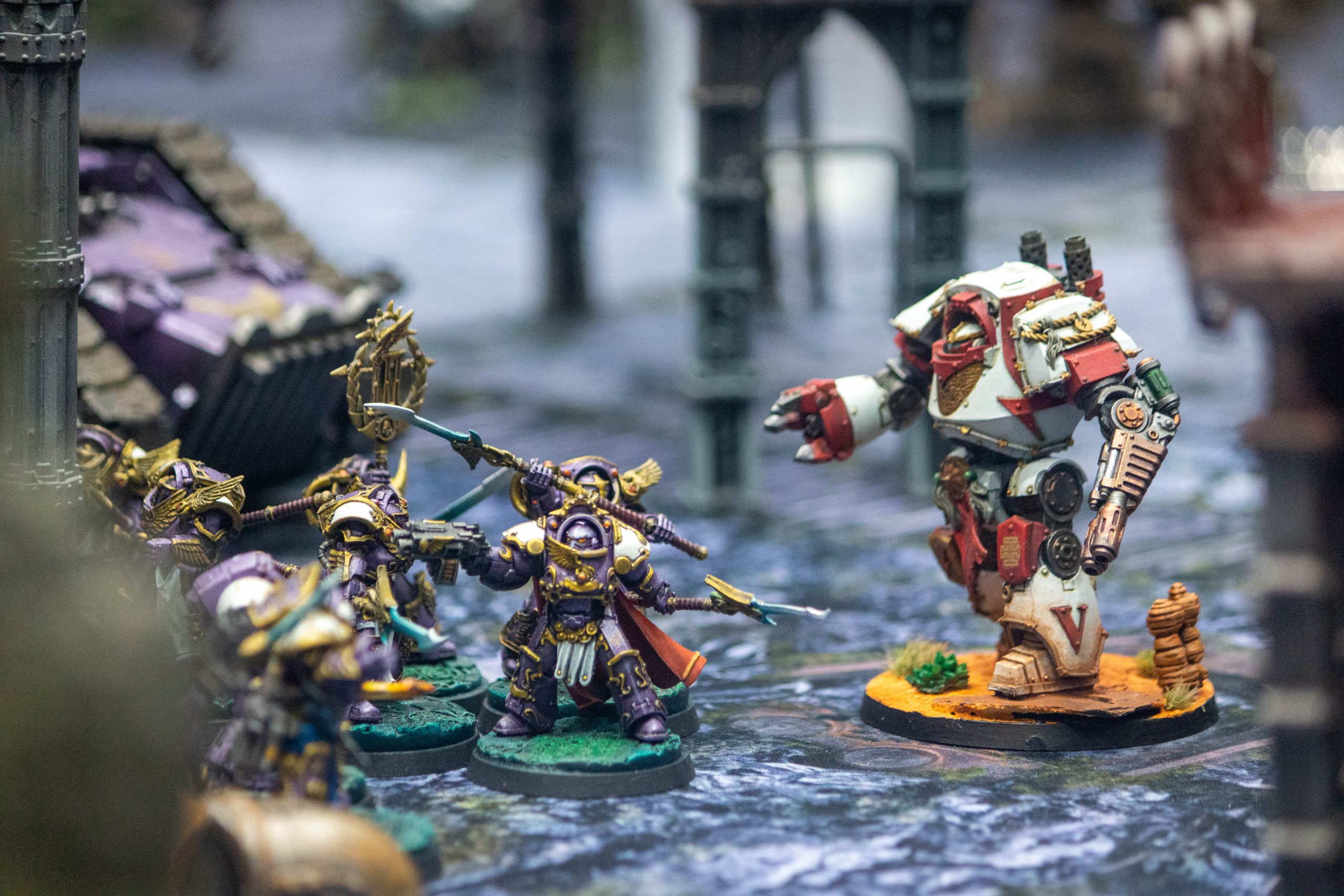
Legion Special Rule
So let’s look at heretical Emperor’s Children. The key special rule, instead of the normal Flawless Execution rule, is Lords of Profligacy. This allows you to have one of your units become Stupefied after a shooting attack is resolved against them, unless it’s Falling Back. They stay stupefied until the end of your following turn.
Being Stupefied does a lot. You get a 6+ mitigation save that works a lot like Feel No Pain, but remember this only kicks in after the enemy shooting that triggers it takes effect. It will help against future attacks though. While Stupefied your unit ignores the effect of Pinning, Blind and Concussive. It doesn’t take morale checks at the end of the movement or shooting phases, though it still takes them in assault. Oh and they get +1S.
The downside of all this is that they can only fire snap shots, can’t make reactions in any phase and all their charges count as disordered.
Legion Advanced Reaction
The Advanced Reaction lets you instead become Stupefied before an enemy shooting attack is resolved, getting +2 to your Stupefied saves against that unit’s shooting.
This is pretty good. Getting pinned or broken is awful and this rule lets you avoid both. A Stupefied unit can still move around, charge the enemy, capture and deny objectives, while a Pinned or Falling Back one cannot. It’s just a shame that you can only choose for your units to become Stupefied in response to being shot and not voluntarily at other times. It means units that get pinned by other events, like enemy deep strikes for example, can’t break out unless your opponent is kind enough to shoot them.
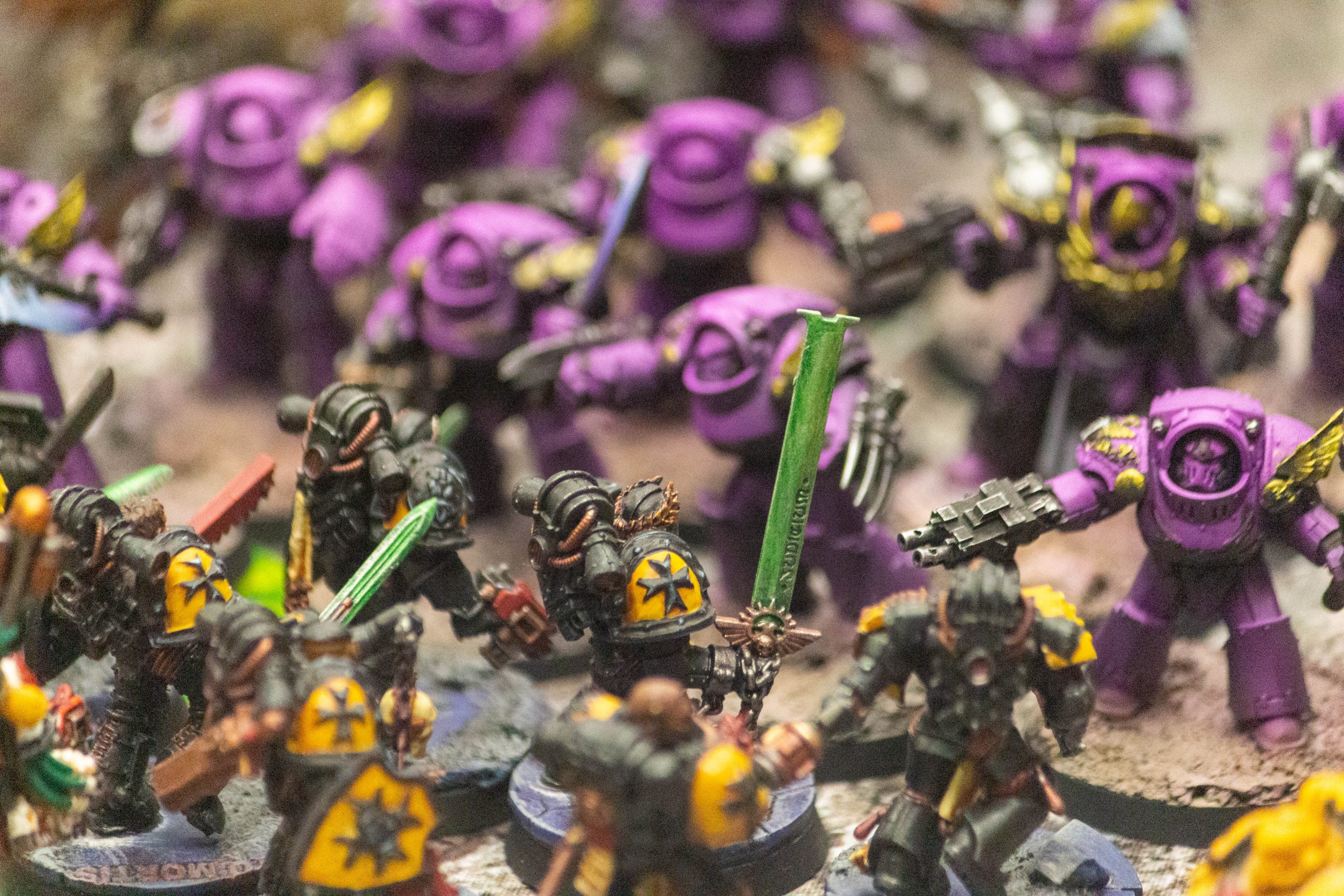
Credit – @__aodhan__ and @le_swordfish
Legion Wargear
In addition to this, heretical Emperor’s Children get access to a new Wargear list. They get Phoenix Pattern Power Weapons identical that are the same as usual. Instead of Surgical Implants they get Debased Implants. For me, the stand-out of these is Warp Scream, which gives the model Hammer of Wrath 1 (or 1 better than it had before, so jump packs do 2 hits) and makes those Hammer of Wrath hits Rending 5+. A squad of the Legacy Palatine Blade Aquilae Squad (Palatine Blades with Jump Packs) could do a lot of rending wounds like this.
The Phoenician’s Hubris rule prevents heretical Emperor’s Children from taking the Phoenix Warden Consul upgrade. Phoenix Terminators lose their Living Icons and Phoenix Retinue rules and get a new one called Fallen from Grace. This gives them +1 to combat resolution if they’re within 6” of other Emperor’s Children, or +2 within 6” of Fulgrim.
They can have The Broken Mirror or Paragon of Excellence as Warlord Traits from the Emperor’s Children section in Liber Hereticus but not Martyrs of Istvaan – which is to be expected as that’s Loyalist only.
Rites of War
There are two new Rites of War, both of which require you to take Fulgrim Transfigured. This seems to mean that you can’t have any Rite of War if you don’t bring Fulgrim, as you lose access to the core ones – it is possible that in future we may see generic Rites of War for Legiones Hereticus.
Brotherhood of the Phoenix
Brotherhood of the Phoenix is the better of the two. You can take up to five HQs (plus of course Fulgrim in your Primarch slot). You can only fill those HQ slots with Legion Champions (in whatever armour you like), Eidolon or Lucius. While Fulgrim is on the board, all these Champions get Preferred Enemy (Everything) – which they will convey on any unit they join.
Preferred Enemy is excellent, providing a great improvement to damage output. Fulgrim can benefit from having a little Champion friend along to make his attacks more consistent, and the Champions themselves will do decent work with their Paragon Blades. As a bonus, it becomes a lot safer to fire plasma guns, assuming you attach a Champion to a unit with a load of plasma.
On the other hand it is a bit of a problem that you can’t have any other types of Characters. You won’t have a Master of Signals to help with reserve rolls, a Herald to make a Death Star into a scoring unit or any Psykers to get up to mischief – including summoning other Daemons.
Children of the Maraviglia
Children of the Maraviglia is the other Rite, and it’s pretty silly. You have to bring Fulgrim and also an allied detachment of Solar Auxilia or Imperialis Militia, with at least four units. You allies gain Stubborn while within 6” of your Heretical Emperor’s Children, who are stubborn themselves until Fulgrim arrives using The Stage is Set rule – a special rule this Rite grants him.
The Stage is Set allows Fulgrim to be put into reserve, but only on his own, not attached to another unit. You get to pick whether he comes in on turn 2-4 (I imagine you would always pick turn 2), without rolling for him. He then deploys wholly within 6” of one of your units at the start of the turn you picked, and not within 1” of the enemy. And then he just sort of loiters there doing nothing for the rest of your turn. He can’t move, has no guns and isn’t given any exception to the normal rule that prevents units from charging on the turn they arrive from reserve.
This is terrible. Even if Fulgrim somehow lives through your opponent’s shooting phase the best you can hope for is that he makes it into melee in turn 3 – unless your opponent charges him in their second turn I suppose. It’s just not a good thing for the most expensive model in your army (and one that you’ll have to spend a vast amount of work painting) to show up half way though the game and then just die.

Conclusion
The main purpose of a review is to advise people whether or not to buy a product. I find it difficult to recommend Exemplary Battles of the Age of Darkness: Volume One, except perhaps to Emperor’s Children players who want to use Fulgrim Transfigured. They’ll need his rules and those for Legiones Hereticus (Emperor’s Children). For them, this book has a decent amount of meaningful content.
I really like the Exemplary Battles articles. They have provided a great bit of extra depth to lots of the Legions, with background stories and exemplary units. The short campaigns are perfect for playing over a day or a few club nights and could easily be made into a small event. But I really object to taking a bunch of previously free articles, pasting them into a book and charging money for it. The result is a book that, for most players, contains rules for only one of their units. It’s hard to see that as good value.
Giving us the rules for Corrupted Emperor’s Children seems like a fairly odd choice, apparently driven entirely by the new (and suitably magnificent) model of Fulgrim Transfigured. Emperor’s Children don’t really have a CSM model range for 40k so it wouldn’t be easy to make your Legiones Hereticus distinct from Legiones Astartes. Why not give us rules for World Eaters, Death Guard and Thousand Sons, along with Angron, Mortarion and Magnus Transfigured? A full Legiones Hereticus book covering all nine Traitor Legions would have been great and I think all the necessary models exist, except possibly a transfigured Perturabo.
It looks like players will need to buy more books in future to have all their Legion’s rules. World Eaters players need this one for their Red Hand Destroyers and will presumably need another in future for Angron Transfigured and Legiones Hereticus (World Eaters). This book doesn’t include The Battle for Kalium Gate exemplary, which features the Emperor’s Children Sunkillers, so if you want that you’ll need some other volume in future. That’s all a bit unhelpful.
But I need to review the book we have, not the one I’d have liked to see. Exemplary Battles of the Age of Darkness: Volume One is fine, for what it is. Perhaps the best thing about this book is that it’s entirely optional. There’s no essential generic unit that means we all need it. It’s a collection of articles, presented nicely, that you can grab if you want – or if you want to put Fulgrim Transfigured on the table.


